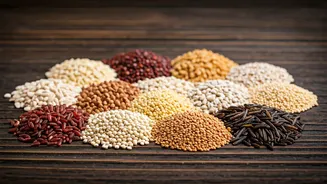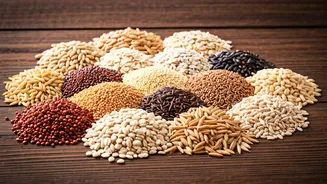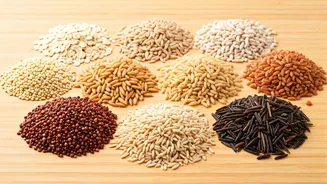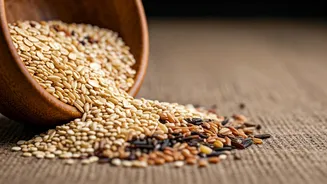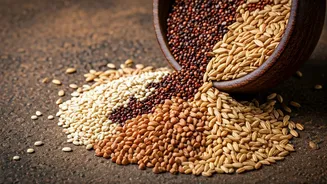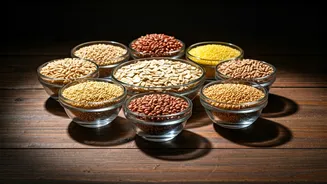Introduction: Diabetes and Grains
Diabetes management often relies on mindful eating, especially regarding carbohydrate intake. The choice of grains significantly impacts blood sugar levels.
Choosing the right grains can prevent sharp spikes and support overall health. This guide highlights 10 grains to incorporate into a diabetes-friendly diet, focusing on both nutritional value and glycemic impact. The grains are selected to provide a variety of culinary options while keeping blood sugar levels steady.
Oats: Heart-Healthy Choice
Oats are celebrated as a breakfast staple and a diabetes-friendly grain. They boast high soluble fiber content, which helps slow down glucose absorption. This gradual release prevents dramatic blood sugar fluctuations after meals. They are also linked to improved heart health, making them a well-rounded addition to a diabetes management plan. Oats can be prepared in various ways: as oatmeal, in baked goods, or as a component in savory dishes. Including oats in the diet can make a practical and nourishing approach to managing diabetes.
Barley: Versatile and Beneficial
Barley is another grain that offers significant health advantages for individuals with diabetes. It has a low glycemic index, which implies it only moderately impacts blood sugar levels. This characteristic makes barley an excellent choice for keeping blood sugar under control. Barley is a versatile ingredient, adding a pleasant nutty taste and chewy texture to dishes such as soups, salads, and side dishes. Moreover, barley is also a great source of fiber, aiding digestion and promoting a feeling of fullness, which can assist in weight management, a vital aspect of diabetes care.
Quinoa: A Complete Protein
Quinoa is a pseudo-grain packed with nutrients and considered a complete protein, meaning it has all nine essential amino acids. It has a low glycemic index and provides substantial fiber. Its high fiber and protein content contribute to controlled blood sugar and enhanced satiety. This grain is an adaptable ingredient, suitable for use in salads, as a side dish, or as a substitute for rice. Quinoa's nutritional benefits make it a great option for people with diabetes, making it a valuable addition to a balanced diet and a healthy lifestyle.
Brown Rice: Fiber-Rich Option
Brown rice is a whole-grain alternative to white rice that is rich in fiber and has a lower glycemic index. This means it has a less drastic impact on blood sugar levels compared to refined grains. The fiber in brown rice slows down the absorption of glucose, avoiding rapid spikes. It also provides essential nutrients like magnesium and selenium, which can benefit overall health. Brown rice is an adaptable grain that can be served as a side, used in stews, or included in salads. Its mild flavor and firm texture make it a popular and beneficial choice for those managing diabetes.
Whole Wheat: Fiber Powerhouse
Whole wheat, when consumed in moderation, is a beneficial choice for people with diabetes, because it has more fiber compared to refined wheat products. This fiber helps regulate blood sugar by slowing down digestion and absorption of glucose. Whole wheat can be incorporated into your diet in many ways: through bread, pasta, or as an ingredient in various meals. Whole wheat contains beneficial nutrients, such as iron and B vitamins, that further enhance its value in a well-rounded diet. Opting for whole wheat over refined options is an easy dietary adjustment for improved blood sugar control.
Bulgur: Quick and Easy
Bulgur is a quick-cooking whole-wheat grain, and it is a good option for people with diabetes due to its moderate glycemic index and high fiber content. The fiber helps manage blood sugar levels and promotes better digestion. Bulgur has a nutty taste and a light texture, making it an excellent addition to salads, pilafs, or as a substitute for rice or couscous. Being a quick-cooking grain, bulgur is a convenient and nutritious choice for those who are short on time but still want to maintain a diabetes-friendly diet. Its balanced nutritional profile supports both health and convenience.
Millet: Nutrient-Dense Choice
Millet is a gluten-free grain that offers a wealth of nutrients and is suitable for individuals with diabetes. It has a low glycemic index, which contributes to less pronounced effects on blood sugar levels. It's a great source of magnesium, which plays a role in glucose metabolism. Millet can be used in a variety of ways: as a breakfast porridge, in salads, or as a side dish, providing a mild flavor and versatile texture. Including millet into a diet adds variety while supporting diabetes management, providing essential nutrients that improve overall health.
Amaranth: Ancient Grain Power
Amaranth, a grain-like seed, is another nutrient-rich option for people with diabetes. Its low glycemic index helps to prevent blood sugar spikes. It is a complete protein source and is also rich in essential nutrients, like iron and magnesium. Amaranth can be used in various culinary ways: cooked as a porridge, popped like popcorn, or used to thicken soups and stews. Incorporating amaranth into your diet provides a nutritious and adaptable alternative, supporting blood sugar management and general health. Its versatility and nutritional density make it a valuable addition to a diabetes-friendly meal plan.
Spelt: Ancient Grain Benefit
Spelt is an ancient grain with a lower glycemic index compared to modern wheat varieties, making it a viable option for managing diabetes. It offers good levels of fiber and nutrients, including manganese. Fiber content helps manage blood sugar levels, and spelt has a pleasant, nutty flavor. It can be used as a replacement for wheat in bread, pasta, and baked goods, improving the nutritional content of the diet. Choosing spelt can be a helpful dietary shift, aiding in blood sugar control and providing a nutritious base for various meals. It is a flavorful and nutritious way to support a diabetes-friendly diet.
Conclusion: Choosing Wisely
Choosing the right grains is an essential aspect of managing diabetes. The ten grains discussed offer a variety of options for incorporating fiber and essential nutrients into the diet, while also helping to regulate blood sugar levels. The article emphasizes the importance of understanding the glycemic index of each grain. Incorporating these grains into your meals can enhance the flavor of dishes, and assist in maintaining health and wellness. Making informed choices about grains can make a big difference to those managing diabetes, supporting both blood sugar control and overall well-being.
